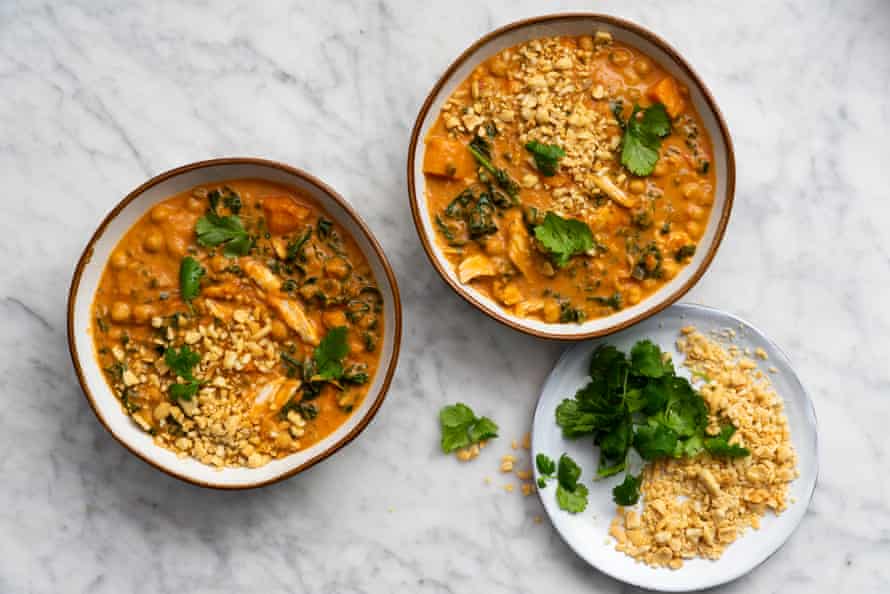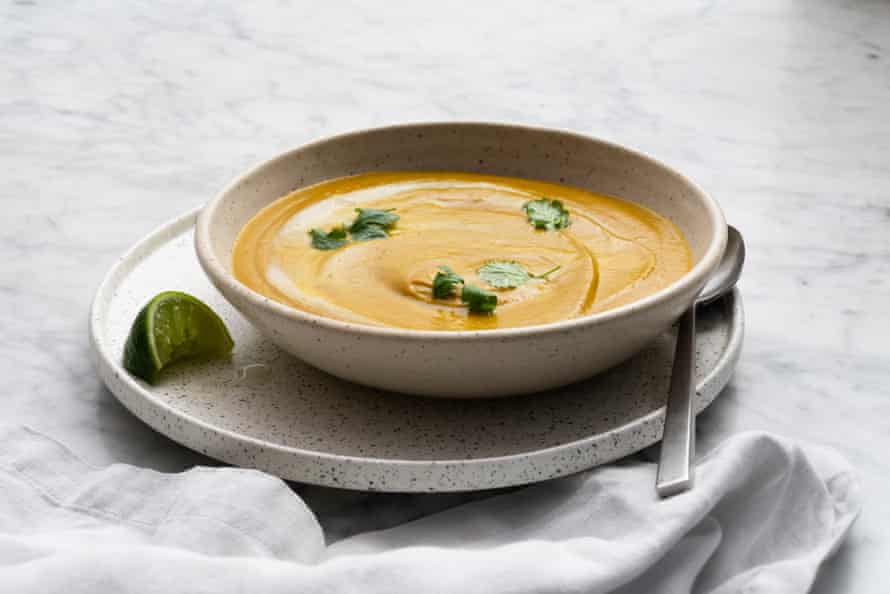
For many Australians, incessant rain has made it feel as though we are already well into the winter months. As the weather cools and the sun begins to set earlier, there’s nothing better than sitting down with a filling bowl of soup to keep warm.
After surveying a selection of Australia’s best chefs and cafe owners on their favourite soup, the classics came up time and time again. From different varieties of pumpkin soup to a family recipe for minestrone, one thing became clear: soup does not have to be complex to be tasty.
‘The classic’
Nicole Morris, chef/owner of Two Eight Two Eight, Gulargambone, NSW
The soup: country-style pumpkin soup
In a town of only 400 people, Nicole Morris and her team, largely comprising volunteers and high school students, are tasked with creating a crowd-pleasing soup in the town’s main cafe.
“I get pumpkin, parsnip, carrots, celery and some veggie stock,” says Morris. “I cook them all up for about twenty minutes. Then I add some salt and pepper and sour cream, and she’s ready to go.”
The simplicity of the soup means that Morris can cater for a range of dietary requirements, keeping it vegetarian and gluten-free. Her one tip for making a killer pumpkin soup?
“Don’t cook it too long. You want it to be tender, you don’t want it to be stewed to the end of its life.”
‘The soup that opened my mind’
Duncan Welgemoed, chef at Africola, Adelaide, SA
The soup: African peanut soup
For South African Duncan Welgemoed, African peanut soup evokes feelings of nostalgia and flavours of home.
“It’s a very thick, rustic soup that uses many ingredients already in your home,” he says. “You use peanut butter as a base, then you add cumin, seasoning and a bit of fresh chilli.”
Welgemoed adds the ingredients to a large pot over medium heat and brings them to a boil. He then lets the soup simmer for 15 minutes before serving.
“You cook that and basically serve it in a bowl with some braised greens and a few strips of roasted chicken.”
According to Welgemoed, the peanut butter is the heart of the soup, and it’s important to get the balance right. “Make sure to add enough peanut butter so that it thickens, but not so much that it becomes like a curry. If you have too much, then add a touch of coconut milk.”
‘A real nice, hearty soup’
Pasquale Trimboli, co-owner of Italian & Sons, Canberra, ACT
The soup: vegetarian Tuscan ribollita
The Tuscan ribollita is a soup that reminds Pasquale Trimboli of home. With origins dating back to the middle ages, this substantial soup is a great way to use up bread that’s past its prime.
“I start off with onion, carrot, celery, and a little bit of garlic to make a basic soffritto. Then I like to throw in kale, spinach, tomato and a bit of chilli for some depth.”
“You’re basically cooking off your soffritto, adding your vegetables, throwing in your crusty bread and cannellini beans and adding parmesan rind right at the end.”
Trimboli believes the key to this soup is the crunchy bread and flavoursome parmesan rind.
“You want stale bread that you’re about to throw out, so it’s crunchy. I also put parmesan rind in the soup water as it’s cooking and then pull it out before serving to give a robust flavour.”
‘Beautiful and fresh’
Erfan Jalilian, managing director of Shiraz Authentic Persian Restaurant, Gold Coast, QLD
The soup: aush reshteh (Persian noodle soup)
Self-professed soup lover Erfan Jalilian says the Persian staple aush reshteh overdelivers on the effort-to-taste ratio.
“You use a lot of fresh herbs like parsley and coriander, and you blend them all up and cook them with sautéed onions and turmeric.”
After that, Jalilian will add noodles and a variety of beans (he uses chickpeas and red kidney beans, but says some people also use white beans) before slow cooking the broth for a few hours, ensuring the consistency is perfect.
“Frankly, this dish is not that difficult. But you want to make sure it is not too thick or too watery. Make sure you add water gradually, otherwise you will lose all the spices [turmeric, salt and pepper] and flavours when you drain it.”
Jalilian tops the soup with a dried sour yoghurt called kashk, but sour cream can also be used at home.
‘One of the easiest dishes to make’
Marc Kuzma, owner of Claire’s Kitchen at le Salon, Sydney, NSW
The soup: french onion soup
According to French restaurateur Marc Kuzma, from-scratch french onion soup is “one of the easiest dishes to make”.
“You put onions in a heavy-bottomed pan, then you sauté your onions in the duck fat,” he says. “It takes 10-15 minutes, and you need to make sure you stir all the time, so the onions don’t catch at the bottom of the pan.”

“Once they are golden, you add cognac, white wine and reduce the wine by half. Then you add beef stock and it’s ready to eat.”
Kuzma says the final ingredients are key: “It’s all in what you use. Using a good quality cognac and white wine is very important.”
Claire’s Kitchen french onion soup recipe
Serves 4
For the soup
½ tbsp duck fat
1kg onion, finely sliced
½ cup cognac
½ litre white wine (Chardonnay is best)
1 litre rich beef stock
For the garnish
1 tbsp chopped flat-leaf parsley
Grated gruyere cheese
Croutons
Saute the onion in duck fat until the onion is golden and soft. Flambe the onions with cognac.
Add white wine. Boil until broth is reduced by half then add the rich beef stock. Continue to boil until the soup is hot. Season to taste with salt and pepper.
Serve very hot topped with croutons, gruyere cheese and chopped parsley to taste.
‘Just keep it simple’
Kobi Ruzicka, head chef of Dier Makr, Hobart, TAS
The soup: classic chicken soup
Kobi Ruzicka, who heads up one of the hottest restaurants in Hobart, reckons that the humble chicken soup is unbeatable.
“I like to keep it really clean with just a few things like fresh ginger and cardamom. Then it’s just bringing it to a boil and almost poaching the chicken, so the broth is really tasty.”
Ruzicka says keeping the soup simple ensures a clear and flavoursome outcome.
“It’s in fashion to just add everything, like celery, carrots, onions, everything. But if that doesn’t stop, you end up with a very muddied overall flavour. For people cooking soup at home, just keep it simple.”
‘Warm and bright’
Ravi Prasad, owner of Parliament on King, Newtown, NSW
The soup: Sally’s salmon mohinga (Burmese fish noodle soup)
Ravi Prasad often asks chefs in his kitchen to start with the dish they are most comfortable with. Now head chef of Uma, May Sally Win’s Burmese salmon soup immediately blew him away.
“Sally made a small test batch,” he says. “And it was an absolute revelation. It leaves you with a clean palate. It tastes warm and bright – more summery than wintery.”
“Sally uses red salmon and chickpea powder. She makes a base as if she is preparing a soffritto for a pasta. She then reduces and simmers the spices [turmeric, sweet paprika, garlic, salt and black pepper] and onions and then puts the salmon directly into the soffritto so that it releases its flavours into the oil.”
“It should be really smooth – it’s not a chunky soup, it’s more like a cream of chicken soup texture.”
‘A one-pot wonder’
Nornie Bero, chef/owner of Mabu Mabu, Yarraville, VIC
The soup: kingfish tip consommé with Warrigal greens, wild rice
“I’m an island girl, so I’m into the brothy fish soups that I grew up with,” says Nornie Bero.
“[To make one] you get some basic vegetables like celery and onions and sweat them off. Then you put in your fish tips in with ginger and garlic. You then add water to finish it off and let it sit there and simmer. It’s basically a one-pot wonder.”
Bero usually adds native ingredients like bush tomato to give extra flavour to her stock, and adds a cup of rice to the broth for substance. She says the trick to her soup is not overcooking the fish.
“You don’t want your fish falling off the bone. You want it holding together so you have those nice chunks of whole fish.”
‘Fresh and healthy’
Iain McTavish, director, Ladle and Press, Perth, WA
The soup: roast pumpkin, carrot and turmeric soup
Iain McTavish is a firm believer that the quality of produce and stock will determine the success of a soup.
“When [soup] comes out of the packet, it’s like water whereas our soup is a lot thicker.”
“I slow roast the vegetables like pumpkin and carrot overnight with some onion, ginger, curry leaves and palm sugar. Then we use some vegetable stock, puree [the soup] and add some coconut cream. Pretty simple.”
When making soup at home, McTavish urges restraint.
“People get carried away by adding 17 different herbs and spices, but most of our soups have six ingredients. It’s how you use them that gets you the best flavoured soup.”

Ladle and Press’s pumpkin, carrot and turmeric soup recipe
Serves 6
500g pumpkin, cut into chunks with the skin on
250g onion, cut into halves
250g carrot, cut into rough chunks
175g potato, cut into halves wtih the skin on
Vegetable oil
1 ½ tbsp turmeric powder
1 ½ tbsp ginger
1 ½ tbsp curry powder
1 ½ tbsp palm sugar
1-2 cloves garlic
10 curry leaves
1 litre vegetable stock
250ml coconut cream
½ cup salt
Coat vegetables lightly with vegetable oil. Mix pumpkin, onion, carrot, potato, ginger, garlic, curry leaves, curry powder, salt over two oven trays.
Slow roast in the oven at 140 degrees for 3 hours.
Remove and put into a large pot and fill with vegetable stock. Bring to a boil and simmer for 45 minutes.
Puree soup with a stick blender. Add coconut cream and season to taste. Pass through a strainer for a smoother finish and allow to cool slightly before serving.
‘My mother and grandmother taught me’
Clare Falzon, executive chef of Hentley Farm, Barossa Valley, SA
The soup: Italian minestrone
Clare Falzon’s minestrone soup has been passed down through generations.
“Everyone has their own version of minestrone,” they say. “My mother and grandmother taught me [my version], which is more of a clear broth than a stew.”
While Falzon says minestrone requires some preparation, they believe it is one of the simpler soups for people at home to make.
“I start off by frying some of the heartier vegetables for about five minutes on medium [heat] until an aroma starts and they get a light golden colour. Then I add the beans and cook them into the flavour. Then I’ll put the broth in and let it simmer for about an hour (or until the vegetables are al dente). I put in the softer vegetables and pasta at this point and turn up [the heat] slightly. It’s ready to eat once the pasta is cooked.”
‘A good way to clean out and reset’
Ben Shewry, head chef/owner of Attica and co-founder of Attica Soup Project, Melbourne, VIC
The soup: whatever is in your pantry!
Ben Shewry believes soup is a great way to clean out your fridge. It lets you use up extra produce from those grocery-store impulse buys, in a delicious and nutritious way.
“I use soup as a way to not waste food,” he says. “[A few days ago] I went to my fridge and got some capsicums, shallots, onions, meat best described as ‘leftover taco meat’, overripe tomatoes and coriander, and used them to make a soup. It’s a great way to clean out the pantry.”
Shewry says that trial and error is the best way to nail soup flavour patterns, and even if something is not working, you can come back to it and tweak it.
“If you’ve been working at your soup for a while and it’s not tasting right, come back and taste it again after a glass of water.
“The worst that can happen is you might ruin some ingredients you were going to discard anyway. It helps your cooking skills when you cook with what you have, rather than needing to follow a recipe.”



